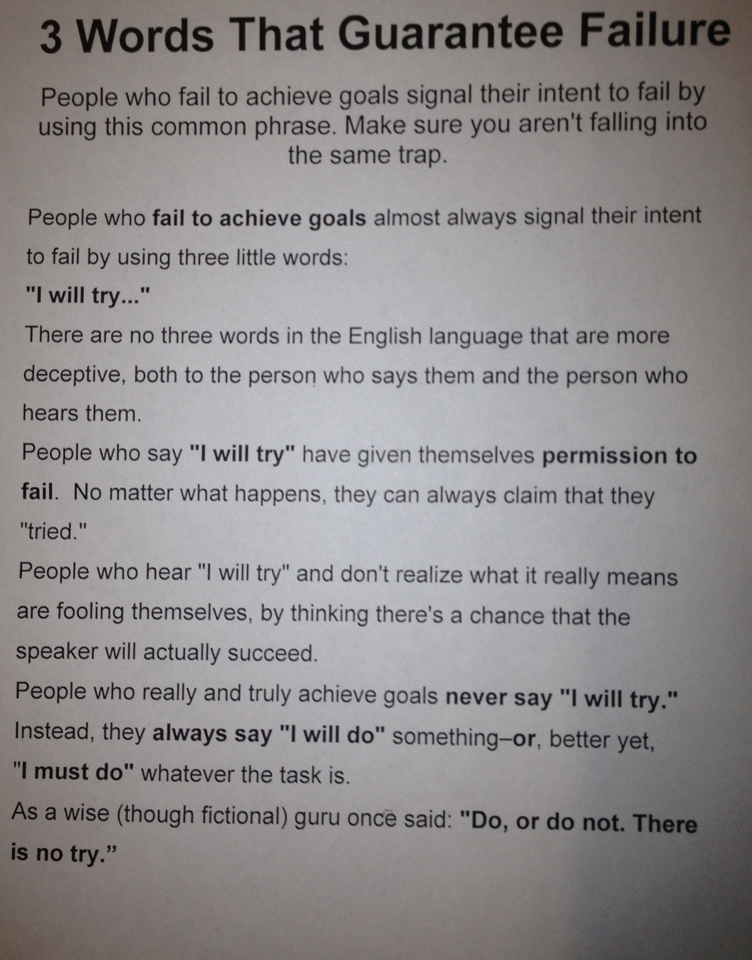I was reading an article by Joyce Russell in Forbes Magazine- FAILURE IS AN OPTION IF WE LEARN FROM IT. There were so many good examples we can learn from this.
Remember in the movie Apollo 13 the Commander at the NASA mission control center said: “Failure is not an option?” We often think exactly that when at the gym. We try to portray an image of how we have it all together and are always succeeding.

I had lunch the other day with one of the first gymnasts I ever coached. We were talking about how I did what I did and how I managed to coach at such a high level at a relatively young age. I told her my goal was to always just stay a day or two ahead of them. Everything in the gym was a gamble. I just had to place my bets carefully. I knew I was going to make mistakes. I just needed to remember the lesson and move on.
There’s plenty of advice noting that a failure is definitely an option. Talk to ANY coach of ANY sport who has been coaching for a few decades. They will tell you that the lessons learned from failures are more important than the lessons of success. Talk to any venture capitalist in Silicon Valley and they will tell you that if you are an entrepreneur then you needed to have failed (and bounced back) a number of times before they even consider your pitch. Likewise, most CEOs will point out times over their career that they have failed and what they have learned from those experiences. In fact, many say that sharing their vulnerabilities enables others to more closely identify with them.
Yet, today, young adults are having more and more trouble dealing with the slightest failures – getting an A- on a project or missing a few items on a test seems to be devastating for some of them. Getting negative feedback from a coach seems to shatter some gymnasts self-esteem.
Clearly, we want our gymnasts and other coaches to succeed, but we also want them to learn that failure is a part of life and what’s most important is how to bounce back from those failures. We think of resilience as a gymnast’s ability to bounce back from, learn, and flourish during obstacles and adversity.
You can’t develop resilience with just success in your life. You have to experience setbacks in order to build resilience, but the good news is that your resilience gets stronger each time you overcome challenges or obstacles. But, we have to understand what happened from our failure – reverse engineer it to see what we can learn from this experience. We have to understand what failure means in terms of new opportunities. Our leaders and workplaces can help us with this.
As coaches, we shouldn’t shelter gymnasts from failures, but rather help them see them as learning opportunities within a safe environment. This is easier said than done. Our tendency is to immediately reprimand or place blame, rather than explore what happened and what they can learn from it. And yet, enabling them, especially younger gymnasts, to learn what happened and how they can move on is critical for building their own resilience and later success!
We need to teach coping strategies in our gyms as well. We need to help the gymnasts develop the right attitudes, behaviors, and a strong social support system. It’s more important than ever before since the world has gotten increasingly more complex. At the gym, we could help them learn a variety of strategies such as:
- Helping them to build stronger connections and relationships so that they have a support group. Setting up mentoring relationships so that they have others to talk with.
- Building a culture of giving or doing for others. There is plenty of research on the benefits of volunteering or focusing on others, which enhances one’s own happiness. Many gyms have programs for giving back to their communities. Getting gymnasts and coaches involved in these “give back” programs can really add to their own feelings of happiness and worth and often put things into perspective for them (i.e., my failures are not really that big in the larger scheme of life”).
- Teaching them mental agility and toughness. Teaching them how to confront the problem and learn from it. Also, mindfulness is a powerful tool that people are practicing to deal with the increasing stress at school or gym.
- Teaching them how to reframe the situation or think about it differently by pausing, reflecting and trying to understand what they are experiencing. Talking about it with others can help.
- Sharing gratitude stories. Getting them to focus on what they are grateful for and what positive aspects may have come from the failure.
- Helping them cope by teaching life skills of getting the right amount of sleep, hydrating and eating healthy to balance out what they are doing in the gym and make sure that they can handle what life throws at them.
You only have to turn on the news to see that adults and children alike are having more trouble coping with failure. As leaders at the gym, we can build cultures to strengthen the resilience of the gymnasts we work with by letting them fail and bounce back stronger than ever before. Failure can be an option if we use it to learn life lessons.




 I hear that every morning, Jacoby wakes up happy and realized there’s no reason I can’t, too. He’s always snuggly and wagging and excited that it’s a new day. Instead of waking each morning and wishing my life were different, I decided to wake up thinking of it as a new beginning. No matter what has happened the day before, the morning is always a new opportunity—to change your attitude, your mood, your mind. That was a decision I had to make, a practice to put into play. I talked myself through it everyday until I didn’t need reminders anymore. Now, I awake to stretch my limbs, get some good snuggles, and go outside for some fresh air. Each morning, regardless of whether it’s cold outside or I’m especially sleepy, is a fresh start.
I hear that every morning, Jacoby wakes up happy and realized there’s no reason I can’t, too. He’s always snuggly and wagging and excited that it’s a new day. Instead of waking each morning and wishing my life were different, I decided to wake up thinking of it as a new beginning. No matter what has happened the day before, the morning is always a new opportunity—to change your attitude, your mood, your mind. That was a decision I had to make, a practice to put into play. I talked myself through it everyday until I didn’t need reminders anymore. Now, I awake to stretch my limbs, get some good snuggles, and go outside for some fresh air. Each morning, regardless of whether it’s cold outside or I’m especially sleepy, is a fresh start. During competition season I have to walk Jacoby every once and a while. Every time I walk him, he’s constantly sniffing, listening, alert. I realized that I never paid attention to my surroundings. I was always too busy brooding—looking at my feet or my phone or just lost in negative thoughts. Now, I’m present in each moment of my day. I look up at the sky to notice its blueness and the way the clouds stretch across the horizon. I take deep breaths, inhale the crisp winter air, and give thanks. I listen to the last of the leaves crunching underfoot, and cuddle into the softness of my scarf. It makes me grateful for the small things.
During competition season I have to walk Jacoby every once and a while. Every time I walk him, he’s constantly sniffing, listening, alert. I realized that I never paid attention to my surroundings. I was always too busy brooding—looking at my feet or my phone or just lost in negative thoughts. Now, I’m present in each moment of my day. I look up at the sky to notice its blueness and the way the clouds stretch across the horizon. I take deep breaths, inhale the crisp winter air, and give thanks. I listen to the last of the leaves crunching underfoot, and cuddle into the softness of my scarf. It makes me grateful for the small things. No matter what has happened in his day, Jacoby is always glad to see Matt. He wags. He jumps. He gives kisses and cuddles. He even cuddles up to me when I come over and sit on the couch and he tries to sit on my lap (No easy feat as he is nearly as big as me). While his affection doesn’t exactly translate into my world, I take a cue from him by smiling at people on the street, saying good morning, holding doors open, and paying compliments to friends and strangers alike. Not surprisingly, it makes me feel good to make others feel good.
No matter what has happened in his day, Jacoby is always glad to see Matt. He wags. He jumps. He gives kisses and cuddles. He even cuddles up to me when I come over and sit on the couch and he tries to sit on my lap (No easy feat as he is nearly as big as me). While his affection doesn’t exactly translate into my world, I take a cue from him by smiling at people on the street, saying good morning, holding doors open, and paying compliments to friends and strangers alike. Not surprisingly, it makes me feel good to make others feel good.
